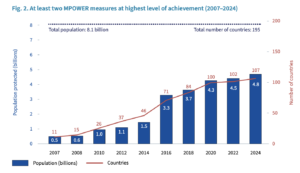Twenty years ago, the WHO Framework Convention on Tobacco Control (WHO FCTC) — the key international treaty in tobacco control — entered into force. Ukraine ratified the WHO FCTC in 2006. Based on the FCTC, the MPOWER package of measures was developed, which includes six main components:
- monitoring tobacco use and prevention policies;
- protecting people from tobacco smoke;
- offering help to quit tobacco use;
- warning about the dangers of tobacco;
- enforcing bans on tobacco advertising, promotion and sponsorship;
- raising tobacco taxes.
According to the WHO Report on the Global Tobacco Epidemic, 2025, about 5.6 billion people are now protected by at least one tobacco control policy aligned with the Convention. This has contributed to a gradual decline in smoking prevalence worldwide.
Graph from the WHO Report on the Global Tobacco Epidemic, 2025
This progress has been made possible by the joint efforts of governments, civil society organizations, associations, and evidence-based international support. Since 2007, more than 400 tobacco control policies have been implemented, including:
- the introduction of graphic health warnings (in more than 100 countries worldwide);
- increased excise taxes on tobacco products (more than 100 countries);
- a comprehensive ban on advertising, promotion, and sponsorship of tobacco products (more than 65 countries);
- a ban on smoking in public places (more than 100 countries).

Graph from the WHO Report on the Global Tobacco Epidemic, 2025
As a reminder, smoking in public places, including all catering establishments, has been banned in Ukraine since 2012, and by 2022, 100% of workplaces in Ukraine will be free from tobacco and e-cigarettes, including heated tobacco products.
Global Tobacco Use Decline
Tobacco control policies truly work. Since the FCTC was ratified twenty years ago, strong, evidence-based measures such as tax increases and pictorial warnings have proven effective in reducing tobacco use and informing the public about its dangers.
Global Progress in Reducing Tobacco Use Thanks to the WHO FCTC:
- Adult tobacco use prevalence declined from 22.7% in 2007 to 17.3% in 2021.
- Over the past decade, about 2 million more people quit smoking.
- 24 million young people never started smoking.
- 35 million premature deaths were prevented worldwide.
This global decline was made possible through active action at national levels.
Ukraine: Steady Implementation of Tobacco Control Policies Despite the War
Ukraine has implemented most of the provisions of the WHO FCTC and MPOWER strategies, showing a high level of population protection even under wartime conditions:
- annual monitoring of tobacco and nicotine product use among adults is conducted;
- all indoor public places are completely smoke-free;
- a free national quitline service operates via stopsmoking.org.ua;
- cigarette packaging carries combined health warnings covering 65% of its surface area, while heated tobacco product and e-cigarette packaging carries 30% text warnings;
- advertising, sponsorship, and promotion of tobacco products, tobacco heating devices, e-cigarettes, and related liquids are banned;
- excise taxes on tobacco and nicotine products are regularly raised: by 2028, cigarette excise is set to reach the EU minimum of €90 per 1,000 cigarettes. The excise rate on e-liquids for e-cigarettes is already fixed at €300 per liter without a multi-year transition, and excise duty on nicotine pouches has also been introduced.
After the implementation of comprehensive tobacco control measures — bans on advertising, smoke-free public places, pictorial health warnings on cigarette packs, and higher excise taxes — adult smoking prevalence in Ukraine decreased by 20% between 2010 and 2017. Among adolescents aged 13–15, smoking prevalence declined by 23% from 2011 to 2017, and by 43% compared to 2005.
Compliance with the smoke-free law remains high: 82% of restaurants in Ukraine comply.
At the same time, due to the emergence and aggressive marketing by the tobacco industry of novel tobacco and nicotine products (e-cigarettes, heated tobacco products, nicotine pouches), tobacco use plateaued and is now rising, especially among children and youth, who are the main consumers of these new products.
Moreover, the share of new tobacco and nicotine product use among children aged 13–15 is higher than among adults:
- 7% of children use heated tobacco products vs. 6% of adults;
- 20% of children use e-cigarettes vs. 5% of adults (four times higher!);
- 3% of children use nicotine pouches vs. 1% of adults.
Currently, new tobacco and nicotine products in Ukraine are not subject to the same regulations as traditional cigarettes, which directly contradicts the principles of the WHO FCTC. Providing them with advertising, tax, and regulatory privileges undermines the progress achieved in public health protection.
To address this issue, Members of Parliament from the Committee on National Health initiated draft law No. 12091, which eliminates regulatory privileges for new tobacco and nicotine products.
In addition, it is important to dynamically increase excise taxes on tobacco and nicotine products, equalize taxation for cigarettes and heated tobacco products, and ban the sale of e-cigarettes and nicotine pouches that are accessible to children and show higher prevalence among minors than among adults.
Ukraine has a successful track record in implementing tobacco control policies, but to preserve progress and protect new generations, it is critically important to prevent the expansion of the market for novel nicotine products. Regulation must keep pace with challenges — in line with WHO FCTC principles and for the sake of public health.
Contact information:
Olha Masna, Media Coordinator, NGO Life
+380 73 089 65 70 | olha.masna@center-life.org


